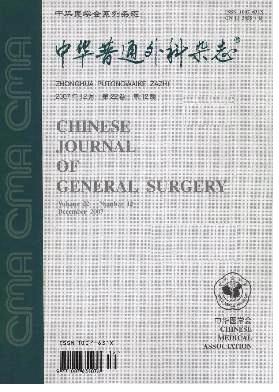Intraoperative sac coiling embolization in type II endoleak high-risk population after endovascular aortic repair
引用次数: 1
Abstract
Objective To investigate the effectiveness and safety of intraoperative sac coiling embolization among patients who are athigh-risk developing type-Ⅱ endoleak after endovascular aortic repair(EVAR). Methods From Jan 2014 to Jan 2018, one hundred and twelve consecutive patients with infra-renal AAA were enrolled for this study, There were 76 patients undergoing standard EVAR (standard-group)and 36 patients doing aneurysmal sac coiling embolization (embo-group). Baseline characteristics, aneurysmal sac parameters, radiological intervention details and follow up results were recorded. Results Mean follow-up time was 25.9 m for embo-group. During follow-up period, no coils-related complications were noted and no type-Ⅱ endoleak associated secondary interventions were reported. A mean of (2.72±1.16) coils (range 1-7) was used in the embo-group. The incidence of type Ⅱ endoleak was 30.3%(23/76) in standard-group and 11.1%(4/36) in embo-group(χ2=4.90, P=0.027). Logistic multivariate analysis revealed that the independent risk factors of type Ⅱ endoleak after endovascular aortic repair for high-risk patients were those EVAR without sac embolization and sac volume≥128 cm3. In the subgroup analysis (sac volume≥128 cm3), the incidence of type-Ⅱ endoleak was lower in embo-group compared to standard-group (χ2=6.07, P=0.014). Conclusion Intraoperative sac coiling embolization in high-risk patients is safe and effective in prevention of type Ⅱ endoleak. This preventive effect is more significant with large sac aneurysm compared to small sac aneurysm. Key words: Aortic aneurysm, abdominal; Radiology, interventional; Endoleak; Risk assessment术中囊圈栓塞在II型内溢高危人群血管内主动脉修复术后的应用
目的探讨血管内主动脉修补术(EVAR)后发生Ⅱ型内瘘风险较高的患者术中气囊螺旋栓塞的有效性和安全性。方法自2014年1月至2018年1月,共有112例肾下AAA患者参加本研究,其中76例接受标准EVAR(标准组),36例接受动脉瘤囊螺旋栓塞(embo组)。记录基线特征、动脉瘤囊参数、放射学干预细节和随访结果。结果embo组平均随访时间为25.9m。在随访期间,没有发现与线圈相关的并发症,也没有报告Ⅱ型内漏相关的二次干预。embo组平均使用(2.72±1.16)个线圈(范围1-7)。标准组Ⅱ型内漏发生率为30.3%(23/76),embo组为11.1%(4/36)(χ2=4.90,P=0.027)。Logistic多变量分析显示,高危患者血管内主动脉修补术后发生Ⅱ型内瘘的独立危险因素为未经球囊栓塞的EVAR和球囊体积≥128cm3。亚组分析(囊体积≥128cm3),embo组Ⅱ型内漏发生率低于标准组(χ2=6.07,P=0.014)。与小囊性动脉瘤相比,这种预防效果在大囊性动脉炎中更为显著。关键词:主动脉瘤,腹部;放射学、介入学;内漏;风险评估
本文章由计算机程序翻译,如有差异,请以英文原文为准。
求助全文
约1分钟内获得全文
求助全文

 求助内容:
求助内容: 应助结果提醒方式:
应助结果提醒方式:


